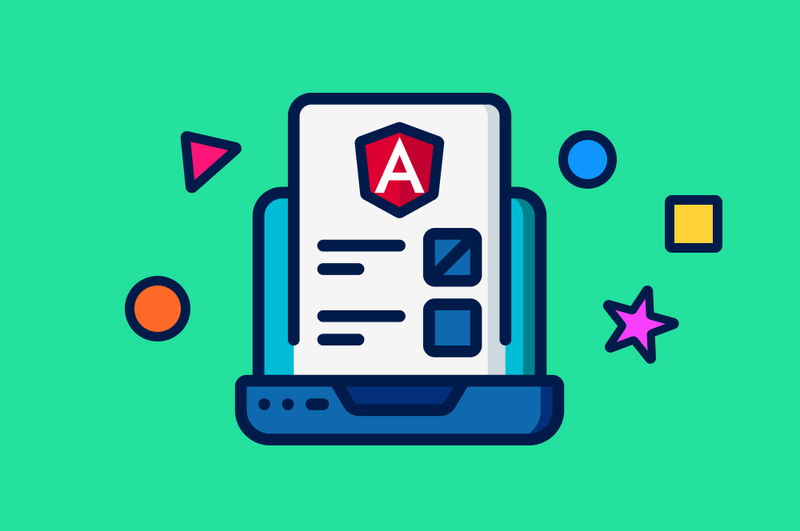Angular Reactive Forms is a way to build forms in Angular using a reactive programming approach. Reactive forms provide a model-driven approach to handling form inputs and validation.
With reactive forms, you create a form model in your component and bind it to your form in the template. You can then use the form model to handle form submissions, track changes to form values, and perform validation.
The main advantages of using reactive forms are:
- They provide a centralized model for handling form data, which makes it easy to perform complex validation and data manipulation.
- They allow for easier testing and debugging of form-related functionality.
- They provide better performance by allowing you to optimize form-related behavior based on user actions.
To use reactive forms, you’ll need to import the ReactiveFormsModule from the @angular/forms module in your module file. You can then use the FormBuilder service to create your form model and bind it to your form in the template.
Here’s an example of creating a reactive form in Angular:
import { Component } from '@angular/core';
import { FormGroup, FormBuilder, Validators } from '@angular/forms';
@Component({
selector: 'app-form',
template: `
<form [formGroup]="myForm" (ngSubmit)="onSubmit()">
<input formControlName="name" placeholder="Name">
<button type="submit">Submit</button>
</form>
`
})
export class MyFormComponent {
myForm: FormGroup;
constructor(private fb: FormBuilder) {
this.myForm = this.fb.group({
name: ['', Validators.required]
});
}
onSubmit() {
console.log(this.myForm.value);
}
}
In this example, we’re creating a simple form with a single input field for the user’s name. We’re using the FormBuilder service to create our form model and binding it to our form in the template using the formGroup directive. We’re also using the formControlName directive to bind the name input field to the name control in our form model.
When the user submits the form, we’re logging the form value to the console. We can also use the form model to perform validation, track changes to form values, and perform other form-related functionality.
Also read: Mostly asked Angular interview questions and answers
Mostly asked Angular reactive forms interview questions and answers
Q1. What are reactive forms in Angular?
Reactive forms are a type of form in Angular that are created and managed programmatically using reactive programming techniques. Reactive forms are built using the ReactiveFormsModule module and provide a more flexible and robust way of handling form data than template-driven forms.
Q2. How do reactive forms differ from template-driven forms in Angular?
In template-driven forms, the form structure and validation rules are defined in the template, while in reactive forms, the form structure and validation rules are defined in the component class. Template-driven forms are easier to use and require less code, while reactive forms provide better control over the form data and validation logic.
Q3. What are the advantages of using reactive forms over template-driven forms?
Reactive forms offer several advantages over template-driven forms, including better control over form data, easier testing, more robust validation, and better support for complex forms with dynamic fields or conditional validation.
Q4. What are form controls and form groups in reactive forms?
Form controls are the basic building blocks of reactive forms and represent individual form inputs such as text boxes, radio buttons, and checkboxes. Form groups are collections of form controls that allow you to group related inputs together and apply validation rules to the group as a whole.
Q5. What is form validation in reactive forms and how can it be implemented?
Form validation in reactive forms involves defining rules that ensure the data entered into the form meets certain criteria. Validation rules can be applied to individual form controls or to form groups, and can be implemented using built-in Angular validators or custom validators defined in the component class.
Q6. What are validators in reactive forms and what types of validators are available in Angular?
Validators are functions that check the validity of a form control or form group. Angular provides several built-in validators, including required, minLength, maxLength, pattern, and email. Custom validators can also be created by defining a function that returns a validation error if the input is invalid.
Q7. How do you dynamically add and remove form controls in reactive forms?
To dynamically add form controls to a reactive form, you can use the push() method on a form array. To remove form controls, you can use the removeAt() method on a form array.
Q8. How do you use form arrays in reactive forms?
Form arrays allow you to group multiple form controls of the same type together into a single control. You can use the form array API to dynamically add or remove controls, iterate over the controls, and apply validation rules to the entire array.
Q9. How do you bind data to a form in reactive forms?
To bind data to a reactive form, you can use the setValue() method to set the value of a form control or form group, or the patchValue() method to update only certain values in the form.
Q10. How do you submit a form in reactive forms and handle the form data on submission?
To submit a reactive form, you can use the submit() method of the form element. Once the form is submitted, you can access the form data using the value property of the form or the getRawValue() method to get the form data as a plain JavaScript object. You can then process the form data as needed, for example by sending it to a server for further processing.
Q11. How do you handle form reset in reactive forms?
To reset a reactive form to its initial state, you can call the reset() method on the form element. This will clear all the form controls and reset them to their default values.
Q12. How do you disable or enable form controls dynamically in reactive forms?
To disable or enable form controls dynamically, you can use the disable() and enable() methods on the form control or form group. You can also use the setDisabled() method to set the disabled state of a control based on a condition.
Q13. How do you handle asynchronous form validation in reactive forms?
Asynchronous form validation involves validating form data using an asynchronous operation, such as an HTTP request or a database query. In reactive forms, you can use the async validator function to perform asynchronous validation. The async validator function should return an Observable or Promise that resolves to a validation error if the data is invalid.
Q14. How do you customize the error messages displayed in reactive form validation?
You can customize the error messages displayed in reactive form validation by passing a second parameter to the built-in validators or by defining custom validation functions that return a custom error message. You can also display error messages using a template or directive that listens for changes to the validation status of the form control.
Q15. How do you handle form data with nested objects in reactive forms?
To handle form data with nested objects in reactive forms, you can use nested form groups to represent the nested objects. You can then use the setValue() or patchValue() methods to set the values of the nested form groups.
Q16. How do you implement conditional validation in reactive forms?
Conditional validation involves validating form data based on a condition. In reactive forms, you can implement conditional validation by using the Validators.compose() method to combine multiple validation functions into a single validator. You can then use the setValidators() method to apply the validator to the form control or form group.
Q17. How do you handle form submission errors in reactive forms?
To handle form submission errors in reactive forms, you can use the catchError() method of the Observable returned by the submit() method. You can then display an error message to the user or redirect them to an error page.
Q18. How do you implement custom form controls in reactive forms?
To implement custom form controls in reactive forms, you can create a custom form control component that implements the ControlValueAccessor interface. You can then use the formControlName directive to bind the custom form control to a form control in the parent component.
Q19. How do you test reactive forms in Angular?
To test reactive forms in Angular, you can create a test component that includes the reactive form and use the TestBed module to configure the test environment. You can then use the ComponentFixture and DebugElement classes to access the form controls and test their behavior.
Q20. How do you handle large forms with many form controls in reactive forms?
To handle large forms with many form controls in reactive forms, you can break the form into smaller components or groups of related fields. You can also use lazy loading or pagination to improve performance when loading large forms.
Q21. How do you implement custom validation in reactive forms?
To implement custom validation in reactive forms, you can create a validation function that returns a validation error if the data is invalid. You can then add the validation function to the list of validators for the form control or form group using the setValidators() method.
Q22. How do you handle form data submission in reactive forms?
To handle form data submission in reactive forms, you can create a method in the component that is called when the form is submitted. This method can use the values of the form controls to send data to the server using an HTTP request or perform other actions based on the form data.
Q23. How do you handle complex form data structures in reactive forms?
To handle complex form data structures in reactive forms, you can use nested form groups and form arrays to represent the data structure. You can then use the setValue() or patchValue() methods to set the values of the form controls for each nested group or array.
Q24. How do you validate forms on submit in reactive forms?
To validate forms on submit in reactive forms, you can use the submit() method of the FormGroup object to submit the form data. Before submitting the form, you can call the markAsTouched() method on the form group to mark all the form controls as touched and trigger their validation.
Q25. How do you handle form data updates in reactive forms?
To handle form data updates in reactive forms, you can use the valueChanges() method of the form control or form group to subscribe to changes in the form data. You can then update the UI or perform other actions based on the changes.
Q26. How do you handle form control focus and blur events in reactive forms?
To handle form control focus and blur events in reactive forms, you can use the onFocus() and onBlur() methods of the form control or form group to subscribe to these events. You can then perform actions based on the focus or blur event, such as displaying a validation message or updating the UI.
Q27. How do you handle dynamic form control creation and deletion in reactive forms?
To handle dynamic form control creation and deletion in reactive forms, you can use the FormArray class to represent a dynamic array of form controls. You can then use the push(), insert(), and removeAt() methods of the FormArray to add, insert, and remove form controls dynamically.
Q28. How do you handle form control value changes in reactive forms?
To handle form control value changes in reactive forms, you can use the valueChanges() method of the form control or form group to subscribe to changes in the form control value. You can then perform actions based on the changes, such as updating the UI or performing calculations based on the new value.
Q29. How do you handle form control state changes in reactive forms?
To handle form control state changes in reactive forms, you can use the statusChanges() method of the form control or form group to subscribe to changes in the validation status of the form control. You can then perform actions based on the new status, such as updating the UI or displaying validation messages.
Q30. How do you handle form data persistence in reactive forms?
To handle form data persistence in reactive forms, you can use a data service to store the form data in a database or other persistent storage. You can then use the data service to retrieve and update the form data as needed.





